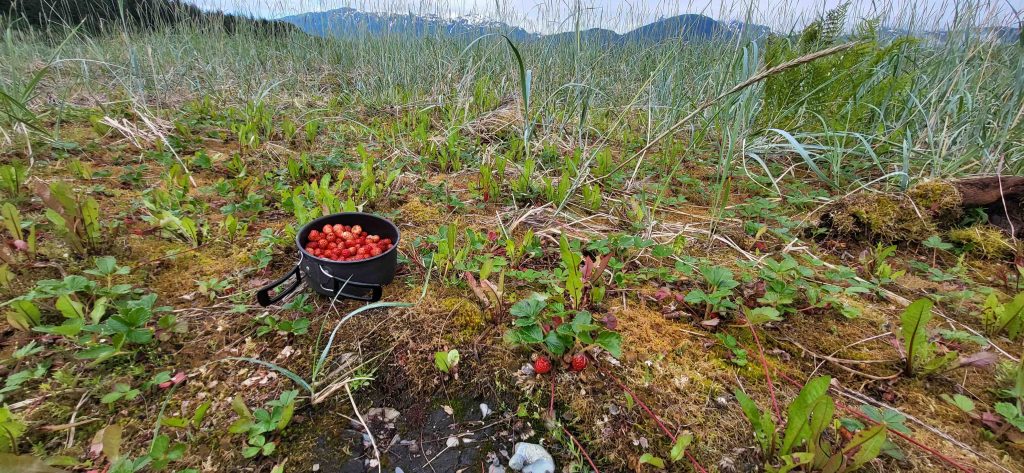 This is a short trace fossil story with two disappointments, one much more than the other. It involves trace fossils made by lingulid brachiopods, a marine invertebrate group with a very long geological history. The earliest appeared in the Cambrian, and, as you can see from the top image, they are very much alive today. (Image of Lingula anatina from Wikipedia.)
This is a short trace fossil story with two disappointments, one much more than the other. It involves trace fossils made by lingulid brachiopods, a marine invertebrate group with a very long geological history. The earliest appeared in the Cambrian, and, as you can see from the top image, they are very much alive today. (Image of Lingula anatina from Wikipedia.)
Lingulid brachiopods have two chitino-phosphatic valves (shown at the left end in the image above) and a long fleshy pedicle (the right end). Unusually for brachiopods, they are infaunal, living with the pedicle vertically down in the sediment. They can flex this pedicle to move their valves up and down in the sediment, maintaining access to seawater which they filter for their food. They have been doing this for hundreds of millions of years with little evolutionary change. Since they are infaunal, they can leave evidence of their burrowing in the sediments, making a particular variety of trace fossil. This is where our story begins.
 While doing fieldwork in the Middle Jurassic Carmel Formation this summer with Team Utah 2022 near St. George, Utah, I found numerous small slabs of sandy-oolitic limestone with roughly circular pits a centimeter or so in diameter (above).
While doing fieldwork in the Middle Jurassic Carmel Formation this summer with Team Utah 2022 near St. George, Utah, I found numerous small slabs of sandy-oolitic limestone with roughly circular pits a centimeter or so in diameter (above).
 This is the steep slope where these particular trace fossils are found. This is our Dammeron Valley location (C/W-773) in “Member D” about a meter above the C/D boundary. It is in the record of a significant transgression Lucie Fiala (’23) is currently studying for her Senior Independent Study project at Wooster. It is also a part of Vicky Wang‘s (’23) Carmel trace fossil Senior IS project.
This is the steep slope where these particular trace fossils are found. This is our Dammeron Valley location (C/W-773) in “Member D” about a meter above the C/D boundary. It is in the record of a significant transgression Lucie Fiala (’23) is currently studying for her Senior Independent Study project at Wooster. It is also a part of Vicky Wang‘s (’23) Carmel trace fossil Senior IS project.
 As shown above back in the Wooster lab, the circular pits have an inverted cone shape, with their diameters decreasing evenly with depth. Most are circular to oval in cross-section.
As shown above back in the Wooster lab, the circular pits have an inverted cone shape, with their diameters decreasing evenly with depth. Most are circular to oval in cross-section.
 Critically, some, like the largest shown above, are oval with sharpish ends, which matches what we expect to see with the compressed valves of lingulid brachiopods moving vertically in the top couple centimeters of the sediment on the seafloor. Now, do they also show traces of the long pedicle below them? Of course they do.
Critically, some, like the largest shown above, are oval with sharpish ends, which matches what we expect to see with the compressed valves of lingulid brachiopods moving vertically in the top couple centimeters of the sediment on the seafloor. Now, do they also show traces of the long pedicle below them? Of course they do.
 This is an eroded cross-section showing the conical pit and a constriction on the bottom end.
This is an eroded cross-section showing the conical pit and a constriction on the bottom end.
 And here is the smoking gun for a lingulid trace. I sawed through one of the pits, which exposed the long sediment-filled trace of the pedicle. Several other cuts showed that this a repeated feature. Lingulid traces they are, and the first found in the Carmel Formation. Note that the sediment here consists of sand-sized particles composed mostly of ooids, then quartz sand grains, and finally fragments of crinoids (the little white bits). Helpfully, the sediments also contain fragments of phosphatic brachiopod shells.
And here is the smoking gun for a lingulid trace. I sawed through one of the pits, which exposed the long sediment-filled trace of the pedicle. Several other cuts showed that this a repeated feature. Lingulid traces they are, and the first found in the Carmel Formation. Note that the sediment here consists of sand-sized particles composed mostly of ooids, then quartz sand grains, and finally fragments of crinoids (the little white bits). Helpfully, the sediments also contain fragments of phosphatic brachiopod shells.
What is the official ichnotaxonomic name for a lingulid brachiopod trace fossil? This is where the first, and most significant, disappointment enters the narrative. In 1976, Eugene Szmuc of Kent State University, Richard G. Osgood of The College of Wooster (and at the time my undergraduate academic advisor), and Deborah Meinke, a Wooster alumna, published a paper describing lingulid trace fossils from the Devonian of Ohio. They christened them Lingulichnites. Unknown to these authors, William Hakes at the University of Kansas was also working on lingulid trace fossils, and also in 1976 he published his name for them: Lingulichnus. Two names for the same trace fossil published in the same year. Which name to use? Or in official terms, which name has priority and which is a junior synonym not to be used except for historical purposes? Turns out the Hakes publication appeared one month before the Szmuc et al. paper. Lingulichnus has priority and is the accepted name for these lingulid trace fossils. Such is science, but the added disappointment is that the issue of Lethaia that carried the Szmuc et al. (1976) paper was delayed in publication by a bad batch of printing paper — a delay of more than a month, thus losing priority on the name. Szmuc et al. had to write a short note in 1977 officially consigning Lingulichnites to junior synonym status. The editors apologized in a statement published with that note.
The second, and minor, disappointment is all on me. I got so excited about these lingulid traces in the Carmel Formation that I started a project to describe them as a new ichnospecies of Lingulichnus. My hypothesis was that these had cone-shaped tops because the brachiopod was twisting its pedicle as it fed, carving out a roughly circular to oval pit different from the sharp-ended slits in the typical Lingulichnus. I did measurements, statistics, saw cuts and photographs as I explored these structures. Lots of exciting work. I should, though, have done my literature searching first …
 This magnificent figure above is from Zonnenveld et al. (2007). This paper, along with Zonnenveld and Pemberton (2003), provides an extraordinary analysis of lingulid brachiopod trace fossils, including new ichnospecies and accounting for all sorts of behavior, even twisting the pedicle. If I had read these papers earlier I would have saved myself a lot of work, work which would have had no novelty for publication. A minor disappointment, but I did learn a lot about lingulids in the process.
This magnificent figure above is from Zonnenveld et al. (2007). This paper, along with Zonnenveld and Pemberton (2003), provides an extraordinary analysis of lingulid brachiopod trace fossils, including new ichnospecies and accounting for all sorts of behavior, even twisting the pedicle. If I had read these papers earlier I would have saved myself a lot of work, work which would have had no novelty for publication. A minor disappointment, but I did learn a lot about lingulids in the process.
Ultimately the importance of these trace fossils for our Carmel Formation paleoenvironmental analysis is that Lingulichnus is the kind of trace that shows an animal living in sediments that were moving frequently enough that it had to adjust its position to increased or decreased sediment levels. That tells us something about the initial stages of this transgression. No research is ever wasted.
References:
Hakes, W.G., 1976. Trace fossils and depositional environment of four clastic units, Upper Pennsylvanian megacyclothems, northeast Kansas. University of Kansas Paleontological Contributions, Article 63, p. 1-46.
Szmuc, E.J., Osgood, R.G. and Meinke, D.W., 1976. Lingulichnites, a new trace fossil genus for lingulid brachiopod burrows. Lethaia 9: 163-167.
Szmuc, E.J., Osgood, R.G. and Meinke, D.W., 1977. Synonymy of the ichnogenus Lingulichnites Szmuc, Osgood & Meinke, 1976, with Lingulichnus Hakes 1976. Lethaia, 10(2), pp.106-106.
Zonneveld, J.P., Beatty, T.W. and Pemberton, S.G., 2007. Lingulide brachiopods and the trace fossil Lingulichnus from the Triassic of western Canada: implications for faunal recovery after the end-Permian mass extinction. Palaios 22:74-97.
Zonneveld, J.P. and Pemberton, S.G., 2003. Ichnotaxonomy and behavioral implications of lingulide-derived trace fossils from the Lower and Middle Triassic of Western Canada. Ichnos 10: 25-39.
 The Fossil of the Week series is no longer weekly, and the beautiful specimen above is not actually a fossil, but the brand is so embedded in this blog that I’m going to use it!
The Fossil of the Week series is no longer weekly, and the beautiful specimen above is not actually a fossil, but the brand is so embedded in this blog that I’m going to use it! The underside of the oyster shows more of the bryozoan. It is heavily eroded, showing the sequential layers of its growth. Inside the cavity is a thin encrusting tube from a serpulid worm. These worm tubes are often found in cavities like this because they prefer cryptic spaces.
The underside of the oyster shows more of the bryozoan. It is heavily eroded, showing the sequential layers of its growth. Inside the cavity is a thin encrusting tube from a serpulid worm. These worm tubes are often found in cavities like this because they prefer cryptic spaces.



























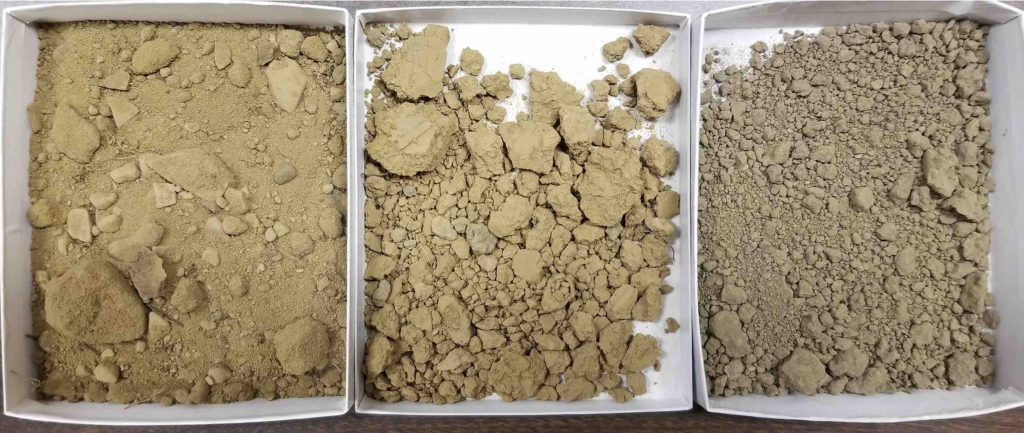






 Big blocks are moved routinely – they are plucked out by the stream along planes of weakness (fractures). Note how the shales break up readily. A block like those above will be mud again in a matter of months. Swelling clays and strong wetting and drying does the job.
Big blocks are moved routinely – they are plucked out by the stream along planes of weakness (fractures). Note how the shales break up readily. A block like those above will be mud again in a matter of months. Swelling clays and strong wetting and drying does the job.
 Stream gaging along Apple Creek. The group gets some hand-on experience with the equipment and puzzles over the various facies of a fining upward fluvial sequence.
Stream gaging along Apple Creek. The group gets some hand-on experience with the equipment and puzzles over the various facies of a fining upward fluvial sequence. Nick and Tyrell take turns in the deep end.
Nick and Tyrell take turns in the deep end.











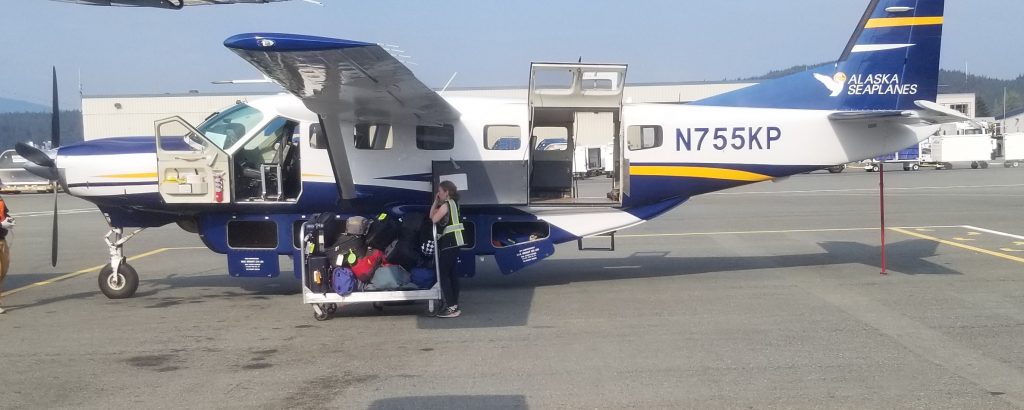

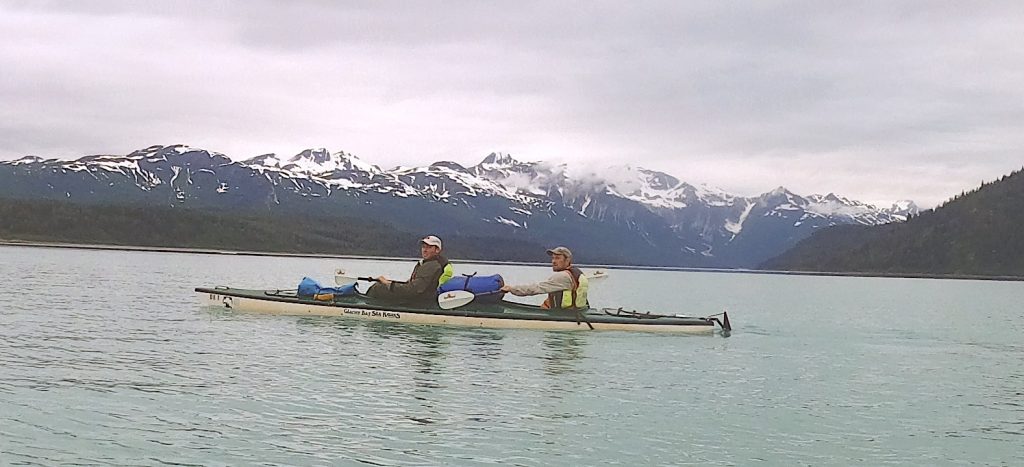





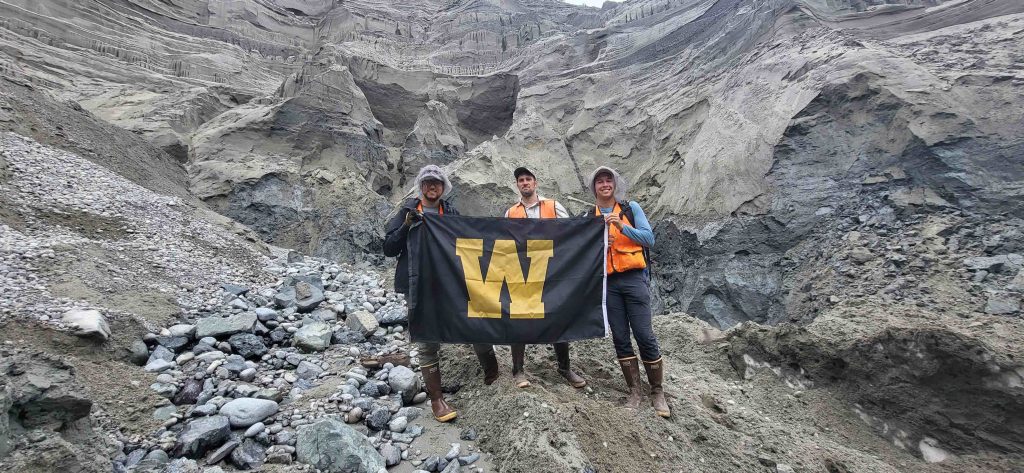


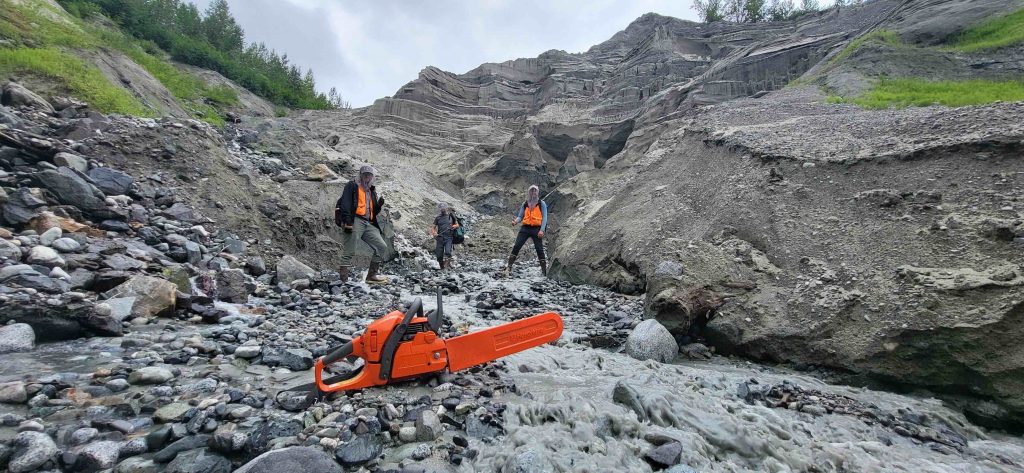





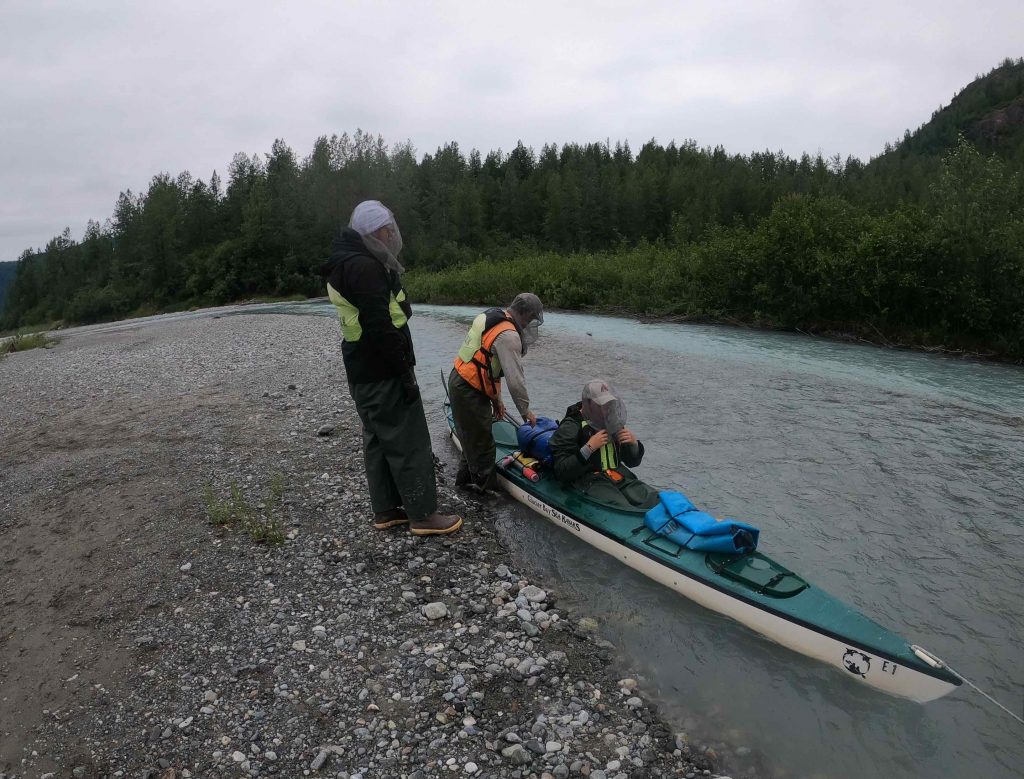
 A view looking west from he Nunatak camp toward Muir Inlet.
A view looking west from he Nunatak camp toward Muir Inlet.

